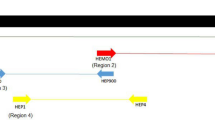Abstract
Canine Hepatozoon species from Brazil was molecular identified and characterized for the first time. From 31 dogs, 7 were positive for blood smear examination and 21 positive for PCR. Partial sequences of the 18S rRNA gene from eight naturally infected dogs were analyzed. Sequences revealed that Brazilian Hepatozoon is closely related with the Japanese Hepatozoon, that has 99% nucleotide identity with Hepatozoon canis from Israel, and different from Hepatozoon americanum. These results indicate that the canine Hepatozoon species from Brazil is H. canis.


Similar content being viewed by others
References
Baneth G, Barta JR, Shkap V, Martin DS, Macintire DK, Vincent-Johnson N (2000) Genetic and antigenic evidence supports the separation of Hepatozoon canis and Hepatozoon americanum at the species level. J Clin Microbiol 38:1298–1301
Baneth G, Mathew JS, Shkap V, Macintire DK, Barta JR, Ewing SA (2003) Canine hepatozoonosis: two disease syndromes caused by separate Hepatozoon spp. Trends Parasitol 19:27–31
Felsenstein J (1985) Confidence limits on phylogenies: an approach using the bootstrap. Evolution 39:783–791
Gondim LFP, Konayagawa A, Alencar NX, Biondo AW, Takahira RF, Franco SRV (1998) Canine hepatozoonosis in Brazil: description of eight naturally occurring cases. Vet Parasitol 74:319–323
Inokuma H, Okuda M, Ohno K, Shimoda K, Onishi T (2002) Analysis of the 18S rRNA gene sequence of a Hepatozoon detected in two Japanese dogs. Vet Parasitol 106:265–271
Massard CA (1979) Hepatozoon canis (James, 1905) (Adeleida: Hepatozoidae) de cães do Brasil, com uma revisão do gênero em membros da ordem carnívora. Seropédica: UFRRJ, Departamento de Parasitologia (Tese, Mestrado) 121 p
Mathew JS, Van Den Bussche RA, Ewing AS, Malayer JR, Latha BR, Panciera RJ (2000) Phylogenetic relationships of Hepatozoon (Apicomplexa: Adeleorina) based on molecular, morphologic and life-cycle characters. J Parasitol 86:366–372
Mundim AV, Jacomini JO, Mundim MJS, Araújo SF (1992) Hepatozoon canis (James, 1905) em cães de Uberlândia, Minas Gerais. Relato de dois casos. Braz J Vet Res Anim Sci 29:259–261
Mundim AV, Mundim MJS, Jensen NMP, Araújo SF (1994) Hepatozoon canis: estudo retrospectivo de 22 casos de infecção natural em cães de Uberlândia, MG. Rev Cent Ciênc Bioméd Univ Fed Uberlândia 10:89–95
O’Dwyer LH, Massard CL, Pereira De Souza JC (2001) Hepatozoon canis infection associated with dog ticks of rural areas of Rio de Janeiro State, Brazil. Vet Parasitol 94:143–150
O’Dwyer LH, Saito ME, Hasegawa MY, Kohayagawa A (2004) Tissue stages of Hepatozoon canis in naturally infected dogs from São Paulo State, Brazil. Parasitol Res 94:240–242
Page RDM (1996) Tree view: an application to display phylogenetic trees on personal computers. Comput Appl Biosci 12:357–358
Paludo GR, Dell’Porto A, Castro e Trindade AR, Mcmanus C, Friedman H (2003) Hepatozoon spp.: report of some cases in dogs in Brasília, Brazil. Vet Parasitol 118:243–248
Saitou N, Nei M (1987) The neighbor-joining method: a new method for reconstructing phylogenetic trees. Mol Biol Evol 4:406–425
Thompson JD, Higgins DG, Gibson TJ (1994) CLUSTAL W: improving the sensitivity of progressive multiple sequence alignment through sequence weighting, position specific gap penalties and weight matrix choice. Acids Res 22:4673–4680
Vincent-Johnson NA, Macintire DK, Lindsay DL, Lenz SD, Baneth G, Shkap V, Blagburn BL (1997) A new Hepatozoon species from dogs: description of the causative agent of canine hepatozoonosis in North America. J Parasitol 83:1165–1172
Author information
Authors and Affiliations
Corresponding author
Rights and permissions
About this article
Cite this article
Rubini, A.S., Paduan, K.d.S., Cavalcante, G.G. et al. Molecular identification and characterization of canine Hepatozoon species from Brazil. Parasitol Res 97, 91–93 (2005). https://doi.org/10.1007/s00436-005-1383-x
Received:
Accepted:
Published:
Issue Date:
DOI: https://doi.org/10.1007/s00436-005-1383-x




